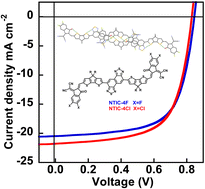Design and synthesis of non-fused non-fullerene acceptors containing naphthobisthiadiazole for organic solar cells†
Abstract
Most of the non-fullerene acceptors that have recently emerged for application in organic solar cells are based on fused rings as the central unit, typically requiring multi-step reactions that inevitably increase the overall cost of the target molecules. To explore more synthetically accessible non-fullerene acceptors, here we designed and synthesized two naphtho[1,2-c:5,6-c′]bis([1,2,5]thiadiazole) derivatives, containing fluorinated and chlorinated dicyanomethylidene-indan-1-one units as the flanking end-groups, which were denoted as NTIC-4F and NTIC-4Cl, respectively. The halogen substitution has trivial effects on the optical and frontier molecular orbital energy levels, while the fluorinated NTIC-4F showed distinct thermal properties and crystallinity compared to the chlorinated counterpart NTIC-4Cl. When blended with the electron-donating polymer PTzBI-dF, both compounds showed good miscibility and favorable molecular orientation, as shown in both atomic force microscopy and transmission electron microscopy images. After processing the PTzBI-dF:NTIC-4F or PTzBI-dF:NTIC-4Cl bulk-heterojunction layer with a trivial amount of chloronaphthalene as the solvent additive, it is noted that the film based on NTIC-4Cl showed a more favorable morphology and thus resulted in slightly higher power conversion efficiency of the organic solar cells. These findings provide guidance for the design of non-fused non-fullerene acceptors based on naphthobisthiadiazole as the central unit.

- This article is part of the themed collection: 2023 Journal of Materials Chemistry C HOT Papers


 Please wait while we load your content...
Please wait while we load your content...